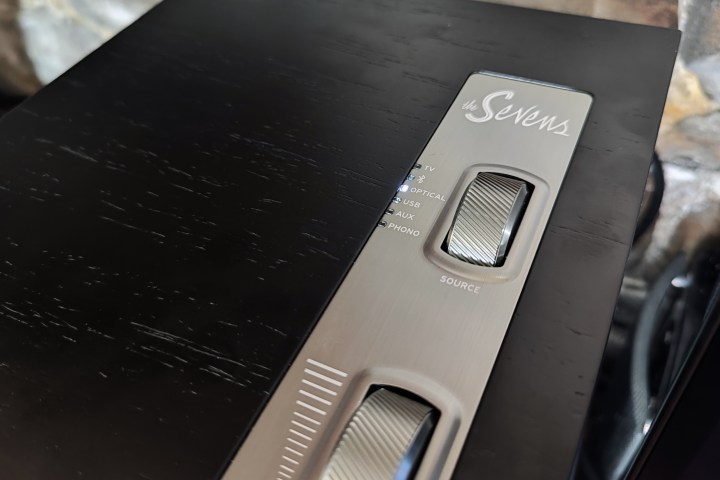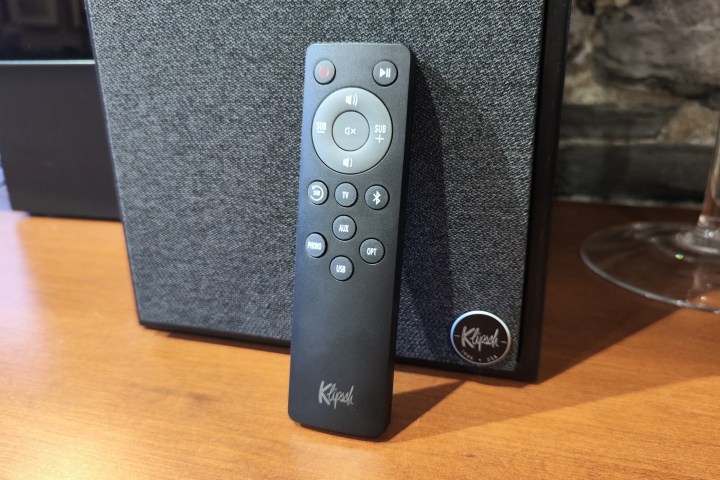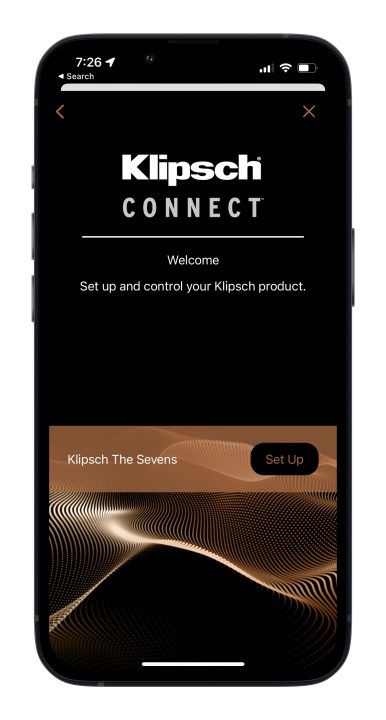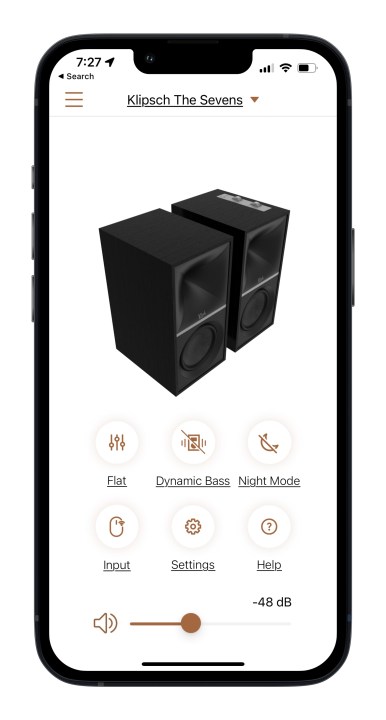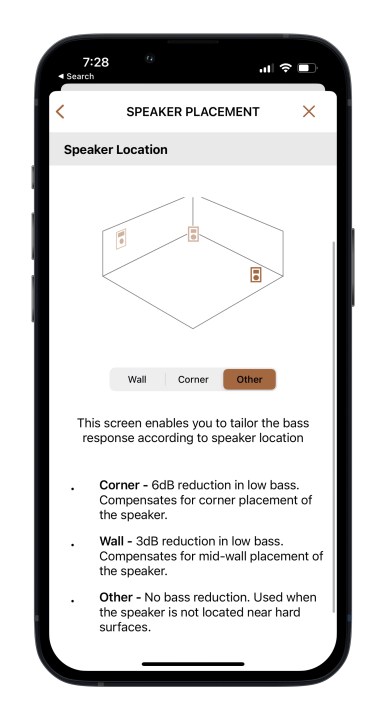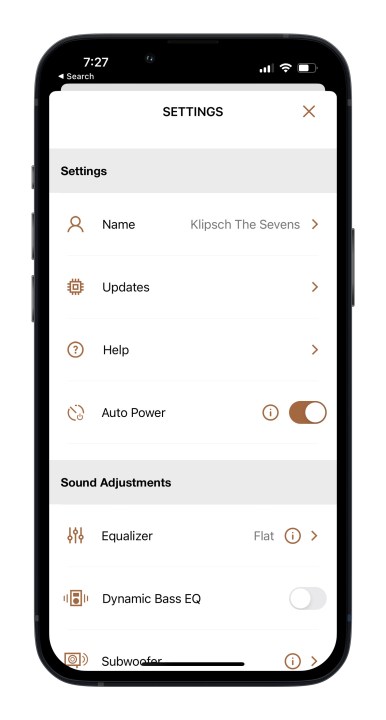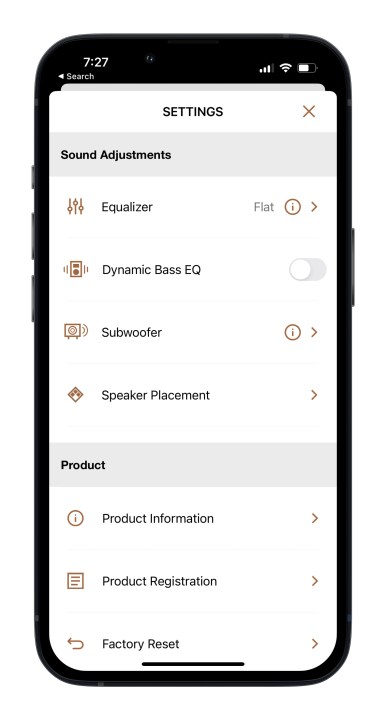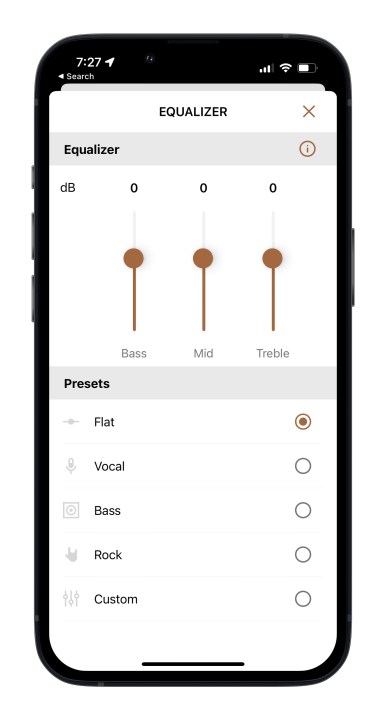
- Incredible sound
- Top-quality design/materials
- Generous inputs
- Adjustable EQ
- No Wi-Fi connection
- Can't see indicators when seated
Home audio, like life itself, is full of trade-offs. Convenience and simplicity typically come at the expense of control, affordability comes at the expense of quality, and products that do many things often fail to excel at any one task. There’s no getting around all of these compromises, but when it comes to creating a simple, powerful hi-fi sound system for both TV and music, Klipsch’s The Sevens ($1,299) are just about perfect.
Welcome to the family

First things first: The Sevens belong to a family of audio products from Klipsch collectively known as Heritage Wireless Room Speakers. They all have two things in common: they can stream music wirelessly via Bluetooth and they’ve got a midcentury modern vibe that immediately brings forth images of the Mad Men era and the Rat Pack vocal stylings of Frank Sinatra, Sammy Davis Jr., and Dean Martin.
As a set of powered stereo speakers, The Sevens are the middle child of a trio of nearly identical models, with The Fives ($969) occupying the entry-level and The Nines ($1,499) sitting at the top. Unlike the rest of the Heritage Wireless family, these three models are intended as full soundbar alternatives.
While reading this review, keep these other models in mind — depending on your space and your budget, they might be a better choice than The Sevens because of their differing power levels, yet feature for feature, they’re almost identical.
Don’t call them bookshelf speakers

I don’t know about your home, but in my house, there isn’t a single bookshelf that’s deeper than 10.5 inches. That pretty much disqualifies The Sevens from the “bookshelf” speaker category as far as I’m concerned. Technically, these beasts are just 10.8 inches deep, which sounds like I’m splitting hairs — 0.3 inches doesn’t sound like much really But that’s not the whole story.
The Sevens use a delightfully overengineered, braided, nylon-wrapped four-conductor audio cable to attach the powered primary speaker with the passive secondary unit. When you take into account the industrial-strength, threaded-collar connectors at each end, you’re going to need a minimum of 13 inches of space. Given that the cabinets feature rear-facing bass ports, you might want to give them even more breathing room. Wondering why the cable is so beefy? The speakers are bi-amped, which means each driver has its own discrete power feed, for more precise tuning.
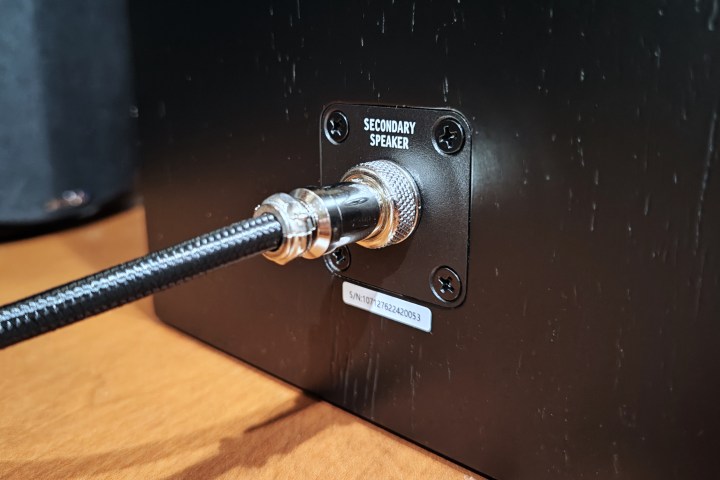
The Sevens are also surprisingly tall at 16.3 inches and wide at 8.1 inches. Stand them next to an average 65-inch TV and they’ll reach the screen’s halfway point. Unless you have a robust media center with lots of extra space, you might want to look into buying Klipsch’s optional speaker stands (there are four threaded mounting holes on the bottom of the speakers to mount them).
The Sevens come with a power cord, a remote, an HDMI cable, a USB cable, a 13-foot speaker cable, and a 6.5-foot speaker extension cable — giving you a maximum distance of 19.5 feet between the speakers.
Looking good

I’m on record as saying that speakers — especially soundbars — should be heard, not seen. However, if you’re going to get a set of speakers that are this big, they had better look fantastic — and The Sevens do. Our review model came in black. It’s a real wood veneer on top of medium-density fibreboard, which gives them a true furniture-grade appearance. They’re also available in a walnut finish.
With the included magnetically latched fabric grilles installed, they become part of the decor. Or you can go naked and let the two massive drive enclosures speak for themselves.
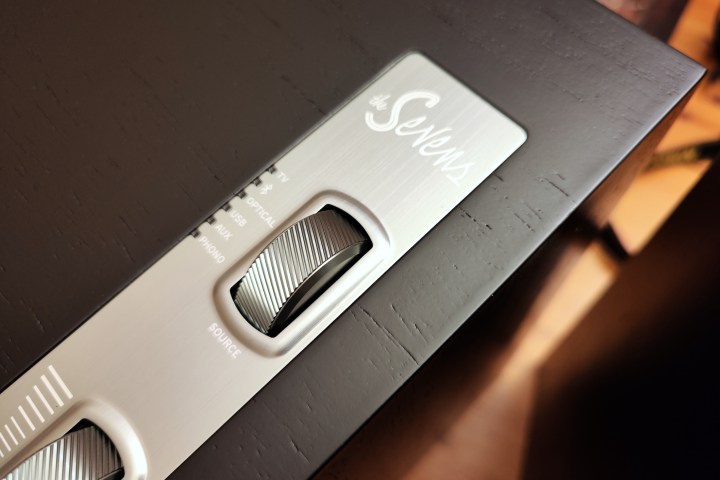
Klipsch has also somehow managed to make The Sevens’ top-mounted controls look like they belong. Instead of trying to hide them, perhaps as a series of small plastic buttons, Klipsch’s designers decided to celebrate them by using oversized, diagonally knurled metal thumbwheels — one for volume and the other for source selection. The remaining controls, which you’ll use far less often, are hidden on the back panel of the primary speaker.
Speaking of the primary speaker, I have to give props to Klipsch for including a selector switch that lets you decide if the primary will be your left or right channel.
Connections galore
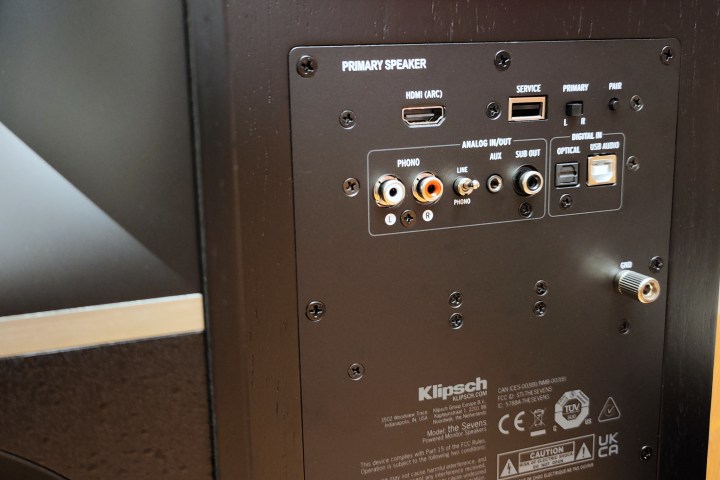
Klipsch says that with The Sevens, you can ditch your AV receiver (AVR) — and that’s not far from the truth. The back panel has three digital inputs (HDMI ARC, optical, and USB) a 3.5mm analog input, and a set of RCA analog inputs that can be toggled for phono use — no need for a separate preamp if you want to hook up a turntable. Keep in mind that because The Sevens don’t support advanced surround formats like Dolby Atmos, there’s no difference in terms of sound quality if you want to connect your TV via optical instead of HDMI ARC.
Unlike so many soundbars I’ve tested with multiple inputs, each input is discrete and selectable with The Sevens. You can theoretically have five audio sources connected simultaneously — six if you include the speakers’ Bluetooth connection. There’s also a subwoofer output, which I’ll discuss later.
Switching sources and adjusting the volume is a breeze with those big thumbwheels, and Klipsch includes an infrared remote so you can manage The Sevens from your couch, but this is one area where the speakers don’t quite cut it as an AVR replacement.
Because all of the indicators for source and volume are on the top of the primary speaker’s cabinet, there’s zero chance you’ll be able to see them from a seated position unless you put them on the floor. Even then, good luck reading them from a distance of more than four feet.
For some, the lack of visual feedback may not be a problem, but I prefer it when gadgets can tell you what’s going on.
The remote itself is well laid out, but it seems to have a very narrow effective angle. If you’re sitting directly in front of the primary speaker — which has the IR receiver on the front — it’s fine. Sit off to the side (which one tends to do with a stereo pair) and it can be hit-or-miss. If you’re using the HDMI ARC connection, your TV’s remote should have no problem sending basic commands.
Basic app
One way around the invisible indicators and the quirky remote is to use the Klipsch Connect app for iOS or Android. It does all of the same things as the remote — plus firmware updates — but it lets you see the result of those changes. It’s not bad as apps go. There aren’t many screens and menus, so it’s easy to navigate.
Unfortunately, it connects via Bluetooth and has a habit of going into a refresh cycle on a regular basis (presumably to make sure it’s still synced with the speakers), which is a bit frustrating at times.
Wimpy wireless

I love that Klipsch has integrated a digital-to-analog converter (DAC) that’s compatible with lossless hi-res audio sources, all the way up to 24-bit/192kHz. But I’m highly perplexed by the decision to limit The Sevens to just Bluetooth for their wireless connectivity.
Bluetooth on these speakers, even with the supported aptX HD codec, isn’t lossless and it tops out at 24-bit/48kHz. That’s assuming you have an Android phone. If you’re on an Apple device, you’ll be getting lossy 16-bit/44.1kHz at best.
The way most wireless speakers deal with this limitation is by offering Wi-Fi connectivity. Sonos, Denon HEOS, Bluesound, Bose, Sony, Yamaha … all of these brands have integrated Wi-Fi into their flagship products because it has (essentially) no limits on bandwidth, and lets you stream at the highest possible lossless quality from both your own collection and from streaming services.
When Digital Trends asked Klipsch why it had omitted Wi-Fi, we were told that the company believes that the vast majority of the source devices connected to the Fives, Sevens, and Nines already support your streaming flavor of choice. I suppose if you include smart TVs with built-in streaming music apps, then maybe that’s true, but you shouldn’t have to turn on your TV to listen to music.
Even if Klipsch didn’t want to go to the trouble of creating an app with streaming services built-in, it could have enabled Wi-Fi for the purpose of supporting Apple’s AirPlay 2 and Google’s Chromecast for audio, both of which would offer better quality (and greater flexibility) than Bluetooth.
Outrageously good sound
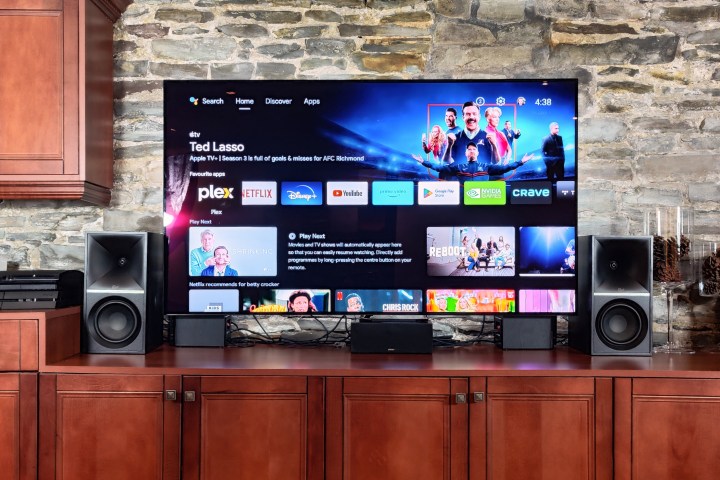
I’m not going to mince words. I love the way these speakers sound. I’ve never auditioned powered monitors that come anywhere close to The Sevens in terms of clarity, precision, soundstage, and bass response. Those 1-inch titanium tweeters, recessed in their Tractrix horn cavities, do such an impressive job at directing sound around the room that there were moments while watching movies when I was convinced I was hearing surround sound — not just two-channel stereo.
I cannot speak highly enough about the 6.5-inch woofers. I’m so used to needing a subwoofer when listening to soundbars, I had already busted out my subwoofer’s cable in preparation for using it with The Sevens. And yet the combination of those woofers along with Klipsch’s Dynamic Bass EQ (which adapts low frequencies as you increase/decrease the volume) proved more than powerful enough to deliver cinematic jolts — I highly recommend HBO’s The Last of Us as a test.
Yes, I did connect my sub to hear the difference, and yes, it improved that delicious low-end even further. Then I disconnected my sub and discovered I didn’t miss it. That says it all.
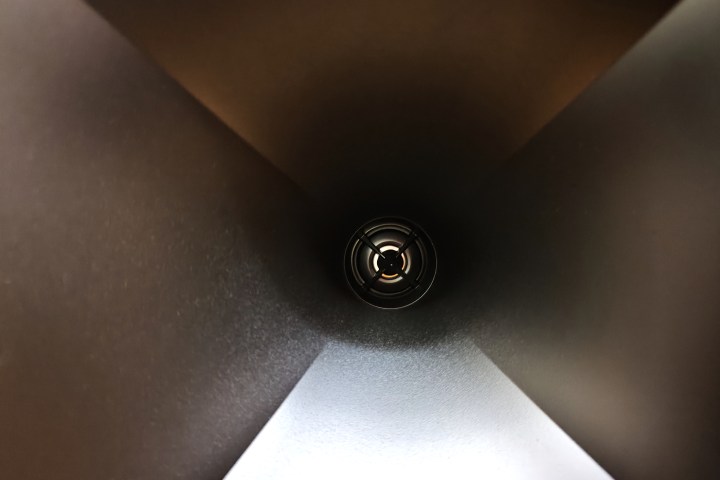
As we noted in our review of The Fives, when it comes to TV sound, The Sevens are very adept at delivering a phantom center channel from just two speakers. Once again, I think those tweeters get the credit. However, they don’t quite live up to the dialogue clarity of the best soundbars like the Bose Smart Soundbar 900 or the Sennheiser Ambeo Soundbar Plus. That’s not really a surprise — it’s pretty hard to beat a central, dialogue-tuned tweeter that’s aimed directly at you. Should you be concerned about it? No. Unless you are very picky about dialogue clarity, The Sevens won’t disappoint.
I will quickly point out that, as a set of stereo speakers, The Sevens don’t do Dolby Atmos. That’s not a criticism as much as it’s a fact; if you want the full 3D immersion of Dolby Atmos, don’t buy these monitors.
However, I will also point out that Dolby Atmos doesn’t have a monopoly on great sound. A well-executed stereo pair like The Sevens, with their superb dynamic range and bass response, will deliver a much bigger emotional punch for your movies and shows than a poorly executed Dolby Atmos sound system.
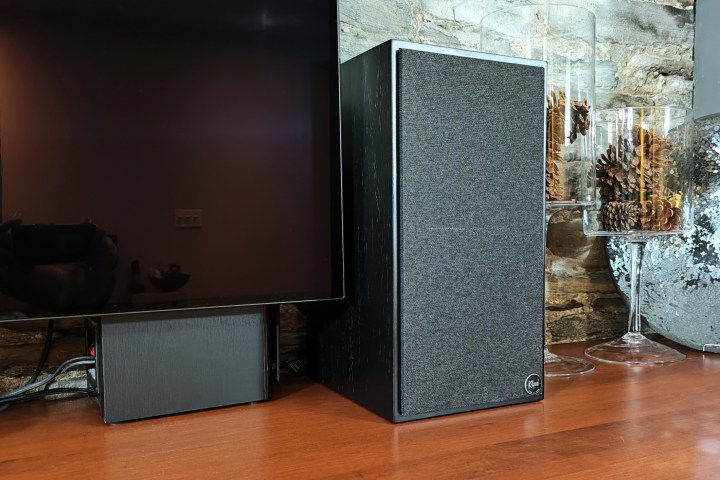
As for music? That’s the real sweet spot for The Sevens. It’s hard to imagine a speaker/amp combo that can deliver this much power and precision for the same level of investment. For medium-to-large rooms, the speakers’ 200 total watts of power (400 peak) will have no problem generating as much loudness as you could want, and without a hint of distortion.
When listening to music, I tend to favor lower volume levels because I find that most systems start to sound harsh once you push them beyond 60% of their volume scale. And yet, I kept turning The Sevens up higher and higher — and they just sounded better and better. I’m not sure my neighbors felt the same way.
I put them through their paces using a Wiim Pro wireless adapter and a wide collection of hi-res and CD-quality lossless tracks from Amazon Music, and I was treated to hours of truly enjoyable listening. From the droning thump of Billie Eilish’s Bad Guy to the soaring orchestration of John Williams’ most famous movie themes, The Sevens reminded me at every turn that all you really need is a great set of stereo speakers.
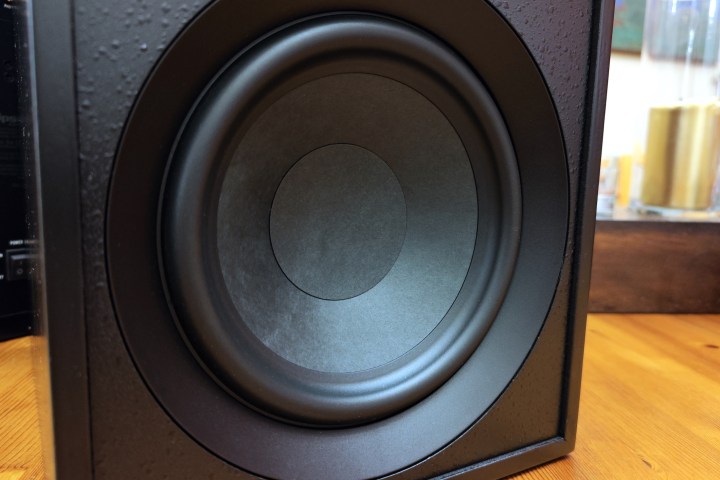
Out of the box, the tuning delivers an admirably flat frequency response, but if it’s not exactly to your liking, the Klipsch Connect app gives you a three-band equalizer for custom settings, along with four presets: flat, voice, bass, and rock. After some playing around, I found that my favorite is the rock preset, which sounds like it gives a slight boost to lows.
Digital Trends Editor-at-large, Caleb Denison — who has been auditioning The Nines — prefers to run those speakers without the Dynamic Bass feature enabled, but I found it helped The Sevens to keep their balance at lower volumes.
The Sevens or a soundbar?
There’s no question that Klipsch is asking a premium price for The Sevens, as $1,299 can buy you a very good Dolby Atmos-capable soundbar-based home theater system, many of which come with their own wireless subwoofers. Beyond their spatial audio compatibility, they also tend to offer full Wi-Fi connectivity and an HDMI input, so you don’t need to sacrifice your TV’s HDMI ARC port just for sound.
And yet, there’s also no question that these products are designed as TV-first systems. If what you want is a true music-first all-in-one setup that can also do double duty as a powerful TV enhancer, The Sevens tick (almost) all of the boxes.

